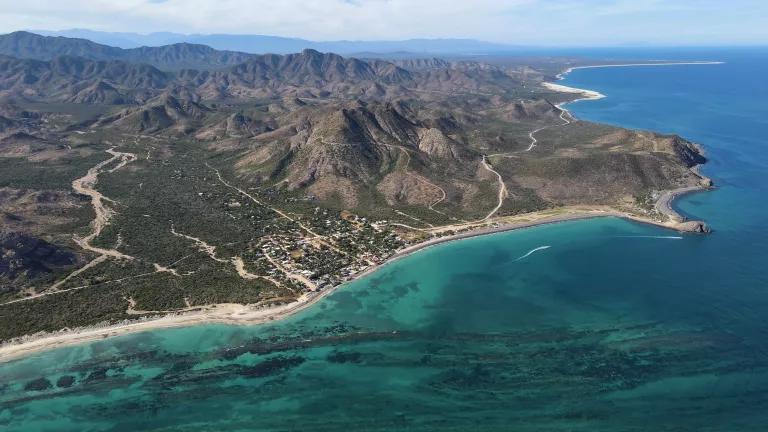
A new study on good practices for coastal tourism in Mexico helps illustrate that the massive Cabo Cortés resort proposed near Cabo Pulmo National Marine Park is the wrong type of project for the region. The report by the Center for Responsible Travel (CREST) highlights how site selection impacts sustainability and recommends best practices drawn from various international institutions. Based on what we know about the proposal, it’s evident site selection for Cabo Cortés did not follow international best practice. The good news is there are ways to make coastal development more sustainable and increasingly that’s what travelers want. With this in mind, President Calderon should swiftly cancel Cabo Cortés. His government should instead work with the local community to define a more environmentally and socially sustainable development path for their region.
CREST notes that “establishing the location of new tourism construction is the development decision with the greatest environmental and social impact” and lays out key factors to consider, including: a site’s environmental significance, appropriate project scale, a location’s commercial viability, and the social context of the proposed site. Critics of the Cabo Cortés project, including local communities, scientists and NGOs, have long pointed to serious concerns precisely along these lines:
- Environmental significance: International good practice for coastal tourism discourages building on or near coastal wetlands and critical wildlife habitat. In stark contrast, Cabo Cortés is proposed directly adjacent to Cabo Pulmo National Marine Park—key habitat for whales, sea turtles, dolphins and over 200 species of fish. In addition, the park is both a Ramsar Wetland of International Importance and UNESCO World Heritage site; and both entities have visited the site to assess the potential impact on Cabo Pulmo. It’s also good practice to avoid building on sand dunes. In fact, the local Ecological Management Plan expressly prohibits such activity. Despite this, Cabo Cortés includes some construction on dunes. The vulnerability of this area was recently underscored when 811 meters of beach “disappeared” when the coastline suddenly came in—a phenomenon that’s still under investigation. Planning a project like Cabo Cortés in such a strikingly fragile area is simply irresponsible.
- Project scale: A tourism project’s size is key to determining its impact and sustainability, particularly near environmentally vulnerable zones. CREST highlights how large-scale, unsustainable tourism degraded Cancún’s natural areas and wildlife. Cancún’s sandy beaches and turquoise waters mask how rampant overdevelopment caused some marine species to disappear locally, destroyed sand dunes and nearby rainforests and impacted underground water systems. Cabo Cortés could rival Cancún in scale and impact. Its projected 27,000 guestrooms, 490-slip marina, two golf courses, jet port and other infrastructure could threaten the fragile Cabo Pulmo coral reef. There are lessons to learn from the environmental impact of Cancún-style development. If Mexico allows the Cabo Cortés project to move forward, it’s clear it’s not paying attention.
- Commercial viability: A tourism project’s commercial viability is not determined merely by the number of rooms. Projects also need basic resources such as freshwater, especially in an arid region like Baja California. Yet there’s still no guarantee that the Cabo Cortés project will have a reliable and sustainable supply of water. The project would depend on a new desalination plant for 65 percent of its water supply, yet this plant has not received permits yet due to a lack of data about the potential impact of discharge on the coral reef. Without a secure and sustainable source of fresh water, Mexico’s decision to approve Cabo Cortés is like putting the cart before the horse—it makes no sense.
- Social Context: CREST’s study highlights that tourism projects should be in line with the wishes of local communities. The Cabo Cortés proposal, however, is contrary to what local communities are striving to achieve. After years of over-fishing nearly depleted the waters surrounding the Cabo Pulmo coral reef, the community joined forces with the government to create the national park and declare it a no-fishing zone. They also re-oriented their economy from fishing to small-scale eco-tourism activities. In the span of ten years, marine life in the park rebounded by 463 percent—a conservation success story that is largely due to the concerted efforts of the local community. A mega-resort like Cabo Cortés could turn back years of efforts by a community committed to protecting the marine preserve it helped create.
Fortunately, as CREST’s analysis shows, there are practices that can minimize environmental impacts. The key is ensuring decision-makers ask the right questions, especially when places like the Cabo Pulmo park are at stake. It’s also encouraging that increasingly travellers aren’t looking for cookie-cutter mega resorts that ignore environmental impacts. According to market surveys CREST consulted, a majority of tourists feel hotels and resorts should protect the environment. It’s clear a growing number of consumers want to be environmentally sustainable and that doesn’t stop when they’re on vacation.
President Calderón must realize that Cabo Cortés is the wrong type of project and cancel it outright. It poses an irreparable threat to Cabo Pulmo National Marine Park, it’s not what local communities envision for their region and it’s not the type of project tourists want.



